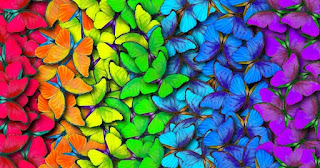People come in all the time asking for help with color choices, usually followed by "I just can't put colors together." Don't get me wrong, I love helping people with their color choices, I think it's the most fun part of the quilting process! But this post is about empowering you to choose the colors you love, and make those tricky color choices when you need to. There are tools for that...Color Theory!
Color Theory sounds like an unnecessary complication to a pretty straight forward concept - choosing colors you like and that look good together and putting them in a quilt. But understanding how colors interact not only is a valuable foundation to have, but it opens up so many creative doors that may have been locked before.Since we're all starting from different experience levels, I'm going to explain Color Theory from the ground up; I'm not insulting anyone's intelligence, I promise, I'm just going to lay it all out so everyone starts on the same page.
This is a seven-part series, from now through July, so hold on to your butts! First up? The super, super basics - Warm & Cool Colors
The Basics
The Basics
If you're one of those folks that claims to be bad at color, this one's for you. What's your favorite color? Is there a color pairing you find yourself buying a lot of for your home or wardrobe? If you can dress yourself, then you can pick color. We all have a reasonably good idea of what colors look good on us, what does nothing for us, and what looks downright God-awful. For me that means jewel tones are winners, beige doesn't do a thing for me, and yellow is just plain ghastly on me. Think about your skin tone - if you're a person that wears makeup, then you have a sense of warm and cool tones (you know this for when you're trying to match your foundation, right?).
Knowing whether you're drawn to warm colors or cool colors is a fabulous starting point when choosing color because it doesn't tie you down to a single color, but gives you a jumping off point in the tones you know you already love.
Like I said before...we're all starting out at different levels here so I'm going to cover it all. So what specifically do I mean when I call out warm or cool colors?
Warm Colors - Red, orange and yellow are your basic warm colors. There's also browns and tan that can be warm too. Warm colors all share a primary base of red. These colors all evoke feelings of warmth (duh), brightness, joy, energy, richness, and give whatever they're in a dynamic edge. They keep the eye moving, especially yellow.
Cool Colors - Traditionally, these are green, blue and purple. Grey, brown, black and beige can also be cool colors if they are blue or green based. Cool colors all share the primary blue base. These colors evoke feelings of calmness, coldness, crispness, luxury (purple isn't called the royal color for nothing!) and freshness.
But, warm and cool is all about the primary base color of red (warm) and blue (cool). So, that means there's some wobblers - think back to your Crayola days. There was purple (cool) but red-violet (also in the purples section) was very definitely warm toned. Think about your neutrals - tan is warm, but take it a couple clicks in the other direction to taupe and you have a cool tone. But you can have blue-y greys (cool) and taupe-y greys (warm). Taupe is a notorious wobbler between warm and cool.
If you're ever unsure about which way a color is going in a fabric you're using, grab something anything handy!) that is a true warm or cool and compare it. Do they blend or contrast? That's a quick way to help reveal a tone. Or, take the piece into different lighting and see if you can see a difference. Fluorescent, incandescent, and LED lighting all cast a different warmth of light so sometimes moving out of one into another can help show where the tones are. Using the basic warm/cool grouping based on where your favorite color is, is a great jumping off point when you're picking colors too.
Next time, we'll dive into Hues and what those do for us.
What's your favorite color or color range? Leave us a comment below!



Blue's and purples!!
ReplyDelete